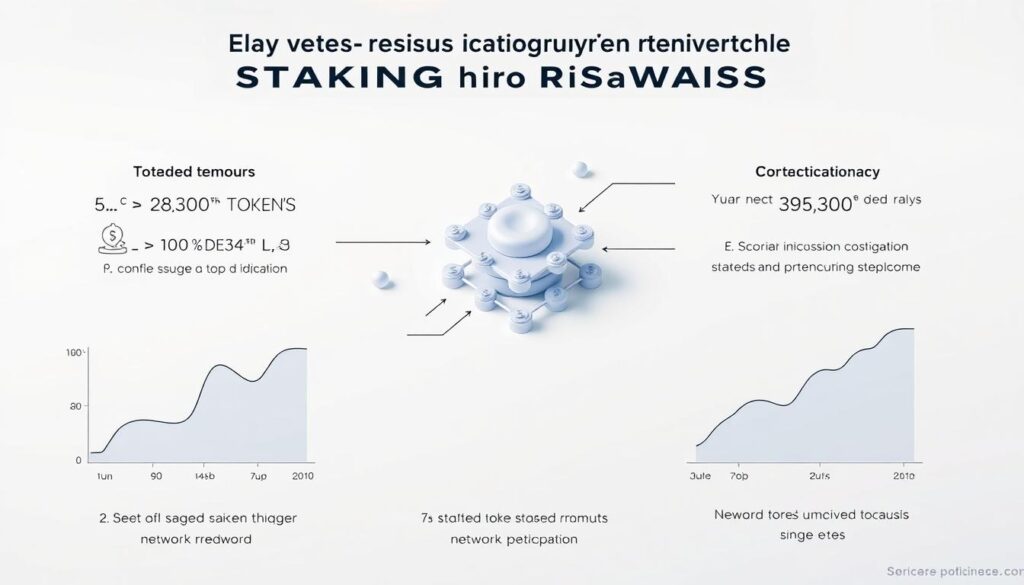Now Reading: Earn Cryptocurrency Staking Passive Income Rewards Explained
- 01
Earn Cryptocurrency Staking Passive Income Rewards Explained
Earn Cryptocurrency Staking Passive Income Rewards Explained

Many digital asset holders now seek ways to generate returns beyond simple price appreciation. This guide explores a popular strategy for putting your crypto to work.
The process involves temporarily locking up your digital assets. This action helps support blockchain network operations. In exchange, participants earn additional tokens.
This method is specific to Proof-of-Stake networks. It differs from the mining process used by Proof-of-Work coins like Bitcoin. Understanding this distinction is crucial for investors.
Potential returns can vary significantly across different platforms and tokens. Some offerings provide modest percentages, while others promise much higher yields. It is essential to research current rates before committing funds.
While this approach can create a stream of earnings, it is not without potential downsides. Market fluctuations and lock-up periods can impact your results. Platform reliability is another important factor to consider.
Key Takeaways
- Staking allows you to earn more digital currency by supporting a blockchain network.
- Only Proof-of-Stake cryptocurrencies support this feature.
- Returns vary based on the token, platform, and network conditions.
- Your assets are typically locked for a set period during the process.
- Market volatility and platform risks can affect your overall earnings.
- This guide will explain how to start, evaluate platforms, and manage risks.
Introduction to Cryptocurrency Staking Passive Income Rewards
The evolving landscape of digital finance presents unique opportunities for asset holders to maximize their returns. This approach functions similarly to earning bank interest or stock dividends but operates within decentralized systems.
Digital assets can work for you instead of sitting idle. By participating in network operations, holders receive compensation for supporting transaction validation. This creates ongoing earnings beyond simple price appreciation.
| Investment Approach | Traditional Method | Digital Asset Strategy |
|---|---|---|
| Return Mechanism | Interest/Dividends | Network Participation |
| Asset Activity | Typically Idle | Actively Supporting Operations |
| Earning Frequency | Periodic Payments | Continuous Rewards |
This method requires minimal ongoing management after initial setup. Your commitment helps maintain network security while generating consistent returns. The process operates automatically without daily attention.
Several factors influence your potential earnings from this strategy. The specific digital asset, participation method, and network conditions all play important roles. Understanding these elements helps optimize your approach for better results.
How Crypto Staking Generates Passive Income
Modern blockchain systems transform how users interact with digital assets through participation-based earning models. Instead of simply holding tokens, you can actively support network operations. This creates a sustainable approach to growing your digital holdings.

Staking Fundamentals and Blockchain Support
The core mechanism involves locking assets to help secure the network. Participants who propose new blocks must commit their own funds as collateral. This ensures honest behavior since fraudulent actions result in financial penalties.
When validators confirm and verify transactions correctly, they receive compensation. The system automatically distributes fees from processed transactions to successful participants. This creates a continuous stream of earnings for network supporters.
Earning Interest and Transaction Rewards
Rewards come from two primary sources: transaction fees and newly created tokens. Each time a validator successfully processes a block, they earn a portion of the included fees. The specific crypto staking rewards structure varies by blockchain network.
Individual participants can delegate their assets to professional validators without running their own infrastructure. This allows smaller holders to benefit from the validation process. Delegators receive proportional shares based on their contributed amount.
The system includes protective measures like slashing penalties for malicious behavior. Validators who attempt to process fraudulent transactions risk losing their staked funds. This security feature maintains network integrity while incentivizing proper conduct.
Earning rates fluctuate based on network activity and total participation levels. More active networks typically offer higher potential returns. Understanding these dynamics helps optimize your participation strategy.
Getting Started With Crypto Staking
Entering the world of blockchain participation begins with selecting the right approach for your situation. The initial setup process involves three main components that determine your experience.

Setting Up Your Digital Wallet
Your first step involves securing a compatible digital wallet. This software stores your private keys and connects to supported networks.
Choose a reputable wallet provider with strong security features. Ensure it supports the specific digital assets you plan to use. Proper setup protects your holdings throughout the process.
Choosing a Validation Method
Participants can validate transactions through different approaches. Your choice depends on technical knowledge and resource availability.
Running your own validator node requires significant technical skill. This method gives you full control but demands constant monitoring. It’s best for experienced users with substantial holdings.
Joining a Staking Pool vs. Self-Staking
Many investors face a crucial decision between independent and collective participation. Each method offers distinct advantages.
Pool participation allows multiple users to combine their tokens. This collective approach meets minimum requirements that might be too high for individual investors.
- Lower barriers to entry – Start with smaller token amounts
- Reduced technical complexity – No need to manage validator infrastructure
- Immediate access – Begin earning without meeting high minimums
Pool operators charge a small commission for their services. Your earnings are proportional to your contribution. This method works well for beginners and those with limited resources.
Self-staking provides complete control but requires more technical involvement. Consider your technical capabilities and desired involvement level when choosing.
Understanding Cryptocurrency staking passive income rewards
The actual value you receive from network participation depends on several interconnected factors. Advertised percentages only tell part of the story.

Interest vs. Reward Models
Different networks use various compensation structures. Some function like traditional interest payments while others use reward-based systems.
The specific model affects how your returns accumulate over time. Understanding this distinction helps set realistic expectations.
APY, Token Inflation, and Market Variability
Annual Percentage Yield (APY) serves as a starting point for calculations. Actual earnings depend on network conditions and token price movements.
New token creation can impact value through inflation. If supply grows faster than demand, individual tokens may lose purchasing power.
Market fluctuations during your participation period affect dollar-denominated results. Your final income reflects both token quantity and market value.
Validator fees and transaction costs reduce effective yields. These expenses vary by platform and network activity levels.
Total participation rates and transaction volume influence individual distributions. More active networks often provide better opportunities for consistent returns.
Benefits and Risks of Staking Cryptocurrency
Every investment strategy carries inherent trade-offs between potential gains and possible losses. Understanding both sides helps you make informed decisions about your digital asset approach.
Why Earn Rewards: Benefits of Securing the Network
Network participation provides multiple advantages beyond simple token accumulation. Your assets actively work to maintain blockchain integrity while generating returns.
This process supports transaction validation across decentralized networks. Participants contribute to security while earning compensation for their involvement.
Potential Risks: Market Volatility and Validator Issues
Market fluctuations represent a significant concern for this investment approach. Token values can decline sharply during the lock-up period, potentially erasing gains.
Validator performance directly impacts your results. Poorly performing validators may experience downtime or engage in behavior that triggers penalties. Understanding what is crypto staking helps identify reliable network participants.

Different blockchain networks implement varying risk parameters. Some impose stricter penalties and longer unbonding periods than others. Researching these differences is essential before committing tokens.
Platform stability represents another critical factor. Exchange failures or bankruptcies could result in loss of staked assets. Ongoing monitoring protects your investment value.
Platforms and Tools for Effective Staking
Your choice of platform directly influences both the security and profitability of your digital asset strategy. Different services offer varying protection levels and cost structures.
Security should be your primary concern when selecting where to place your digital assets. Reputable platforms use cold storage for most funds and offer insurance protection.
Top Crypto Staking Platforms Overview
Leading services distinguish themselves through robust security measures and transparent operations. They provide clear information about validator performance and network participation.
These platforms typically offer two-factor authentication and regular security audits. Some providers maintain dedicated insurance funds to protect user assets against potential breaches.
| Platform Feature | Basic Service | Premium Option |
|---|---|---|
| Security Storage | Partial Cold Storage | Majority Cold Storage |
| Fee Structure | Fixed Percentage | Tiered Based on Volume |
| Insurance Coverage | Limited Protection | Comprehensive Fund |
| Regulatory Compliance | Select States | Nationwide Operations |
Security, Fees, and Regulatory Considerations
Validator commissions and transaction costs can significantly reduce your net returns. Always calculate effective yield after accounting for all associated fees.
Some states maintain restrictions on certain digital asset activities. Users in California, New York, Texas, and several other jurisdictions should verify local regulations before participating.
Platforms operating with regulatory compliance provide greater long-term stability. They’re less likely to face enforcement actions that could disrupt your digital asset strategy.
Prioritize services offering clear fee disclosures and flexible access options. The ability to withdraw assets when needed is crucial for managing your portfolio effectively.
Advanced Strategies for Optimizing Your Crypto Income
Moving beyond entry-level strategies opens up new possibilities for maximizing your digital asset performance. Sophisticated approaches can significantly enhance your financial results.
Diversifying Staked Assets and Leveraging DeFi
Spreading your holdings across multiple networks reduces concentration risk. This approach protects against individual platform issues.
Decentralized finance platforms offer additional earning opportunities. They allow your digital holdings to work more efficiently through various protocols.
Comparing Yield Farming and Traditional Staking
Yield farming involves providing digital tokens to liquidity pools. These pools support trading and lending activities on decentralized platforms.
Traditional network participation keeps your holdings as collateral. It focuses on securing blockchain operations rather than active financial use.
| Feature | Yield Farming | Traditional Approach |
|---|---|---|
| Risk Level | Higher – includes impermanent loss | Lower – network-based security |
| Complexity | Advanced – requires DeFi knowledge | Beginner-friendly – simpler process |
| Potential Returns | Often higher but variable | More predictable and stable |
| Counterparty Risk | Higher – depends on platform success | Lower – rewards from network itself |
Beginners should start with traditional methods for predictable results. Experienced users may explore yield farming for potentially greater earnings.
Each strategy serves different risk profiles and technical comfort levels. Choose based on your experience and financial goals.
Conclusion
Final considerations for digital asset holders involve balancing potential gains with practical safeguards. This approach to blockchain participation offers a legitimate way to enhance your digital portfolio over time.
Beginners should start with flexible options that allow quick adjustments. Testing the process with smaller amounts helps build confidence before larger commitments.
Continuous learning about network economics and validator performance remains crucial. The landscape evolves constantly with new protocols and regulatory developments.
With proper research and realistic expectations, this method can become a valuable component of your overall strategy. It represents a practical way to put your digital assets to work while supporting blockchain operations.
FAQ
What is the main purpose of staking on a blockchain network?
The primary goal is to help secure and validate transactions on the network. By locking up your digital assets, you participate in the consensus mechanism, earning a return for your contribution to the system’s operation.
How does staking differ from traditional savings accounts?
Unlike a bank account with fixed interest, staking returns are not guaranteed. They are tied to network activity, token inflation, and market conditions. This process is part of decentralized finance and carries different risks than traditional banking.
Can I lose the funds I commit to staking?
Yes, there is a risk of losing some of your committed tokens through a process called “slashing.” This can happen if a validator, which you may be delegated to, acts maliciously or goes offline frequently, violating the network’s rules.
What is the difference between a staking pool and running my own validator node?
Joining a pool allows you to contribute a small amount of tokens to a collective stake, managed by a pool operator. Running your own validator node requires a significant initial investment, technical knowledge, and constant uptime, but often offers higher potential returns.
What does APY mean in the context of earning rewards?
APY, or Annual Percentage Yield, is the real rate of return you earn on your staked assets over a year, taking into effect the power of compounding. It’s a key metric for comparing different opportunities across various platforms.
Are the earnings from this activity considered taxable income?
In many jurisdictions, including the United States, rewards generated from staking are considered taxable income. The value of the tokens at the time you receive them is typically subject to income tax. It’s crucial to consult with a tax professional for guidance.
How do I choose a reliable platform or service for my assets?
Look for established platforms like Coinbase, Binance, or Kraken that have strong security measures, transparent fee structures, and a good reputation. Always research the platform’s history, insurance policies, and user reviews before committing your funds.
Is there a minimum lock-up period for my tokens?
Lock-up periods vary by blockchain. Some networks have a mandatory unbonding time when you decide to unstake, which can range from a few days to several weeks. This period is when your assets are illiquid and not earning any returns.














